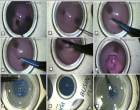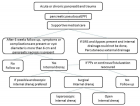Abstract
Research Article
Relationship between Particle Size, Anti-Microbial Activity and Leachability of Copper Particles in Liquid Suspension and Compounded in Polypropylene
Saleh Alkarri* and Jérôme Vachon
Published: 29 May, 2024 | Volume 8 - Issue 1 | Pages: 021-031
Testing the antimicrobial efficiency of plastics with good precision and repeatability remains a challenge in the plastic industry, as commonly used standards can provide unreliable data. In this paper, we show that the “Bacterial Liquid Suspension Test” is a reliable method that allows for the measurement of antimicrobial activity of poor to very potent biocides. We used this technique to discriminate the performance of two Cu-based biocides, either in nanoparticle (NP) or macroparticle (MP) size, at three different loadings (0.02, 0.2 and 2 wt.%) in PP. With this technique, we also tested the antibacterial performance of PP as powders, pellets, and injection molded disks. As anticipated, the technique shows that both the increased loading and the smaller particle size showed higher antimicrobial activity than the larger particle size due to their increased surface area. Also, PP powders showed greater bacterial reduction than pellets and disks. While the PP with 2 wt.% Cu NPs showed the best antimicrobial performance, the detection of Cu at the surface (using SEM-EDX) and in the water leachate (using ICP-MS) were below the LODs, indicating their ability to kill bacteria.
Read Full Article HTML DOI: 10.29328/journal.abse.1001030 Cite this Article Read Full Article PDF
Keywords:
Antimicrobial activity; E. coli K-12 MG1655; Copper particles; Leachability; Compounding
References
Maria Soliman from Sabic T&I for her commitment to proofreading this article.
Author contributions
S.A. led all the processing, performed all the required characterization, and wrote the manuscript. J.V. conducted the ICP-MS and proofread the manuscript.
References
- Ipek C, Gümüş H, Şimşek M, Tosun M. DFT and Molecular Docking Study of 1-(2´-Thiophen)-2-propen-1-one-3-(2,3,5-trichlorophenyl) (TTCP) Molecule as Antiviral to Covid-19 Main Protease. Arab J Sci Eng. 2023;48(1):1031-1040. doi: 10.1007/s13369-022-07293-4. Epub 2022 Oct 27. PMID: 36321067; PMCID: PMC9612599.
- Alkarri S. Developing Methods for Incorporating Antimicrobial Biocidal Nanoparticles in Thermoplastics. Michigan State University, 2023. https://www.proquest.com/openview/3d3600d8ed0e1614fa1c801e2fdf9dc3/1?pq-origsite=gscholar&cbl=18750&diss=y
- Simmons JJP, Composites P. The why, what and wherefore of antimicrobial systems. 2003; 11(2):101-113.
- Kostakioti M, Hadjifrangiskou M, Hultgren SJ. Bacterial biofilms: development, dispersal, and therapeutic strategies in the dawn of the postantibiotic era. Cold Spring Harb Perspect Med. 2013 Apr 1;3(4):a010306. doi: 10.1101/cshperspect.a010306. PMID: 23545571; PMCID: PMC3683961.
- Douterelo I, Jackson M, Solomon C, Boxall J. Microbial analysis of in situ biofilm formation in drinking water distribution systems: implications for monitoring and control of drinking water quality. Appl Microbiol Biotechnol. 2016 Apr;100(7):3301-11. doi: 10.1007/s00253-015-7155-3. Epub 2015 Dec 5. PMID: 26637423; PMCID: PMC4786615.
- Jain A, Duvvuri LS, Farah S, Beyth N, Domb AJ, Khan W. Antimicrobial polymers. Adv Healthc Mater. 2014 Dec;3(12):1969-85. doi: 10.1002/adhm.201400418. Epub 2014 Nov 19. PMID: 25408272.
- Mahira S, Jain A, Khan W, Domb AJ. Antimicrobial materials—An overview. 2019. https://doi.org/10.1039/9781788012638-00001
- Siedenbiedel F, Tiller JCJP. Antimicrobial polymers in solution and on surfaces: overview and functional principles. 2012; 4(1):46-71.
- Santos MRE, Fonseca AC, Mendonça PV, Branco R, Serra AC, Morais PV, Coelho JFJ. Recent Developments in Antimicrobial Polymers: A Review. Materials (Basel). 2016 Jul 20;9(7):599. doi: 10.3390/ma9070599. PMID: 28773721; PMCID: PMC5456892.
- Palza H. Antimicrobial polymers with metal nanoparticles. Int J Mol Sci. 2015 Jan 19;16(1):2099-116. doi: 10.3390/ijms16012099. PMID: 25607734; PMCID: PMC4307351.
- Zapata PA, Tamayo L, Páez M, Cerda E, Azócar I, Rabagliati FM. Nanocomposites based on polyethylene and nanosilver particles produced by metallocenic "in situ" polymerization: synthesis, characterization, and antimicrobial behavior. 2011; 47(8):1541-1549. https://doi.org/10.1016/j.eurpolymj.2011.05.008
- Raloff JJ. Forest invades tundra and the new tenants could aggravate global warming. 2008; 174(1):26-29.
- Prabhu S, Poulose EK. Silver nanoparticles: mechanism of antimicrobial action, synthesis, medical applications, and toxicity effects. 2012; 2:1-10.https://doi.org/10.1186/2228-5326-2-32
- Alkarri S, Bin Saad H, Soliman M. On Antimicrobial Polymers: Development, Mechanism of Action, International Testing Procedures, and Applications. Polymers (Basel). 2024 Mar 11;16(6):771. doi: 10.3390/polym16060771. PMID: 38543377; PMCID: PMC10975620.
- Delgado K, Quijada R, Palma R, Palza H. Polypropylene with embedded copper metal or copper oxide nanoparticles as a novel plastic antimicrobial agent. Lett Appl Microbiol. 2011 Jul;53(1):50-4. doi: 10.1111/j.1472-765X.2011.03069.x. Epub 2011 May 23. PMID: 21535046.
- De Vietro N, Conte A, Incoronato AL, Del Nobile MA, Fracassi F. Aerosol-assisted low-pressure plasma deposition of antimicrobial hybrid organic-inorganic Cu-composite thin films for food packaging applications. 2017; 41:130-134. https://doi.org/10.1016/j.ifset.2017.02.010
- Tamayo L, Azócar M, Kogan M, Riveros A, Páez M. Copper-polymer nanocomposites: An excellent and cost-effective biocide for use on antibacterial surfaces. Mater Sci Eng C Mater Biol Appl. 2016 Dec 1;69:1391-409. doi: 10.1016/j.msec.2016.08.041. Epub 2016 Aug 15. PMID: 27612841.
- Palza H, Quijada R, Delgado K. Antimicrobial polymer composites with copper micro-and nanoparticles: Effect of particle size and polymer matrix. 2015; 30(4):366-380.
- Faúndez G, Troncoso M, Navarrete P, Figueroa G. Antimicrobial activity of copper surfaces against suspensions of Salmonella enterica and Campylobacter jejuni. BMC Microbiol. 2004 Apr 30;4:19. doi: 10.1186/1471-2180-4-19. PMID: 15119960; PMCID: PMC411034.
- Hanczvikkel A, Tóth Á. Quantitative study about the role of environmental conditions in the survival capability of multidrug-resistant bacteria. J Infect Public Health. 2018 Nov-Dec;11(6):801-806. doi: 10.1016/j.jiph.2018.05.001. Epub 2018 May 18. PMID: 29784578.
- Kramer A, Schwebke I, Kampf G. How long do nosocomial pathogens persist on inanimate surfaces? A systematic review. BMC Infect Dis. 2006 Aug 16;6:130. doi: 10.1186/1471-2334-6-130. PMID: 16914034; PMCID: PMC1564025.
- Alkarri S, Sharma D, Bergholz TM, Rabnawaz M. Fabrication methodologies for antimicrobial polypropylene surfaces with leachable and nonleachable antimicrobial agents. 2023; 141(1).
- Brandrup J, Immergut EH, Grulke EA, Abe A, Bloch DR. Polymer Handbook. Wiley New York: 1999; 89. http://nguyen.hong.hai.free.fr/EBOOKS/SCIENCE%20AND%20ENGINEERING/MECANIQUE/MATERIAUX/COMPOSITES/Polymer_Handbook/66286_fm.pdf
- Wiegand C, Völpel A, Ewald A, Remesch M, Kuever J, Bauer J, Griesheim S, Hauser C, Thielmann J, Tonndorf-Martini S, Sigusch BW, Weisser J, Wyrwa R, Elsner P, Hipler UC, Roth M, Dewald C, Lüdecke-Beyer C, Bossert J. Critical physiological factors influencing the outcome of antimicrobial testing according to ISO 22196 / JIS Z 2801. PLoS One. 2018 Mar 20;13(3):e0194339. doi: 10.1371/journal.pone.0194339. PMID: 29558480; PMCID: PMC5860763.
- Williams DB, Carter CB. Imaging strain fields. [Journal Abbreviation]. 2009; 441-461. https://doi.org/10.1007/978-0-387-76501-3_26
Figures:
Similar Articles
-
Investigate the Effect of Coating Concentration and Coating Thickness on the Anti-microbial Properties of Polycarbonate SheetSaleh Alkarri. Investigate the Effect of Coating Concentration and Coating Thickness on the Anti-microbial Properties of Polycarbonate Sheet. . 2024 doi: 10.29328/journal.abse.1001029; 8: 011-020
-
Relationship between Particle Size, Anti-Microbial Activity and Leachability of Copper Particles in Liquid Suspension and Compounded in PolypropyleneSaleh Alkarri*, Jérôme Vachon. Relationship between Particle Size, Anti-Microbial Activity and Leachability of Copper Particles in Liquid Suspension and Compounded in Polypropylene. . 2024 doi: 10.29328/journal.abse.1001030; 8: 021-031
Recently Viewed
-
A Low-cost High-throughput Targeted Sequencing for the Accurate Detection of Respiratory Tract PathogenChangyan Ju, Chengbosen Zhou, Zhezhi Deng, Jingwei Gao, Weizhao Jiang, Hanbing Zeng, Haiwei Huang, Yongxiang Duan, David X Deng*. A Low-cost High-throughput Targeted Sequencing for the Accurate Detection of Respiratory Tract Pathogen. Int J Clin Virol. 2024: doi: 10.29328/journal.ijcv.1001056; 8: 001-007
-
A Comparative Study of Metoprolol and Amlodipine on Mortality, Disability and Complication in Acute StrokeJayantee Kalita*,Dhiraj Kumar,Nagendra B Gutti,Sandeep K Gupta,Anadi Mishra,Vivek Singh. A Comparative Study of Metoprolol and Amlodipine on Mortality, Disability and Complication in Acute Stroke. J Neurosci Neurol Disord. 2025: doi: 10.29328/journal.jnnd.1001108; 9: 039-045
-
Development of qualitative GC MS method for simultaneous identification of PM-CCM a modified illicit drugs preparation and its modern-day application in drug-facilitated crimesBhagat Singh*,Satish R Nailkar,Chetansen A Bhadkambekar,Suneel Prajapati,Sukhminder Kaur. Development of qualitative GC MS method for simultaneous identification of PM-CCM a modified illicit drugs preparation and its modern-day application in drug-facilitated crimes. J Forensic Sci Res. 2023: doi: 10.29328/journal.jfsr.1001043; 7: 004-010
-
A Gateway to Metal Resistance: Bacterial Response to Heavy Metal Toxicity in the Biological EnvironmentLoai Aljerf*,Nuha AlMasri. A Gateway to Metal Resistance: Bacterial Response to Heavy Metal Toxicity in the Biological Environment. Ann Adv Chem. 2018: doi: 10.29328/journal.aac.1001012; 2: 032-044
-
Obesity in Patients with Chronic Obstructive Pulmonary Disease as a Separate Clinical PhenotypeDaria A Prokonich*, Tatiana V Saprina, Ekaterina B Bukreeva. Obesity in Patients with Chronic Obstructive Pulmonary Disease as a Separate Clinical Phenotype. J Pulmonol Respir Res. 2024: doi: 10.29328/journal.jprr.1001060; 8: 053-055
Most Viewed
-
Evaluation of Biostimulants Based on Recovered Protein Hydrolysates from Animal By-products as Plant Growth EnhancersH Pérez-Aguilar*, M Lacruz-Asaro, F Arán-Ais. Evaluation of Biostimulants Based on Recovered Protein Hydrolysates from Animal By-products as Plant Growth Enhancers. J Plant Sci Phytopathol. 2023 doi: 10.29328/journal.jpsp.1001104; 7: 042-047
-
Sinonasal Myxoma Extending into the Orbit in a 4-Year Old: A Case PresentationJulian A Purrinos*, Ramzi Younis. Sinonasal Myxoma Extending into the Orbit in a 4-Year Old: A Case Presentation. Arch Case Rep. 2024 doi: 10.29328/journal.acr.1001099; 8: 075-077
-
Feasibility study of magnetic sensing for detecting single-neuron action potentialsDenis Tonini,Kai Wu,Renata Saha,Jian-Ping Wang*. Feasibility study of magnetic sensing for detecting single-neuron action potentials. Ann Biomed Sci Eng. 2022 doi: 10.29328/journal.abse.1001018; 6: 019-029
-
Pediatric Dysgerminoma: Unveiling a Rare Ovarian TumorFaten Limaiem*, Khalil Saffar, Ahmed Halouani. Pediatric Dysgerminoma: Unveiling a Rare Ovarian Tumor. Arch Case Rep. 2024 doi: 10.29328/journal.acr.1001087; 8: 010-013
-
Physical activity can change the physiological and psychological circumstances during COVID-19 pandemic: A narrative reviewKhashayar Maroufi*. Physical activity can change the physiological and psychological circumstances during COVID-19 pandemic: A narrative review. J Sports Med Ther. 2021 doi: 10.29328/journal.jsmt.1001051; 6: 001-007

HSPI: We're glad you're here. Please click "create a new Query" if you are a new visitor to our website and need further information from us.
If you are already a member of our network and need to keep track of any developments regarding a question you have already submitted, click "take me to my Query."

















































































































































